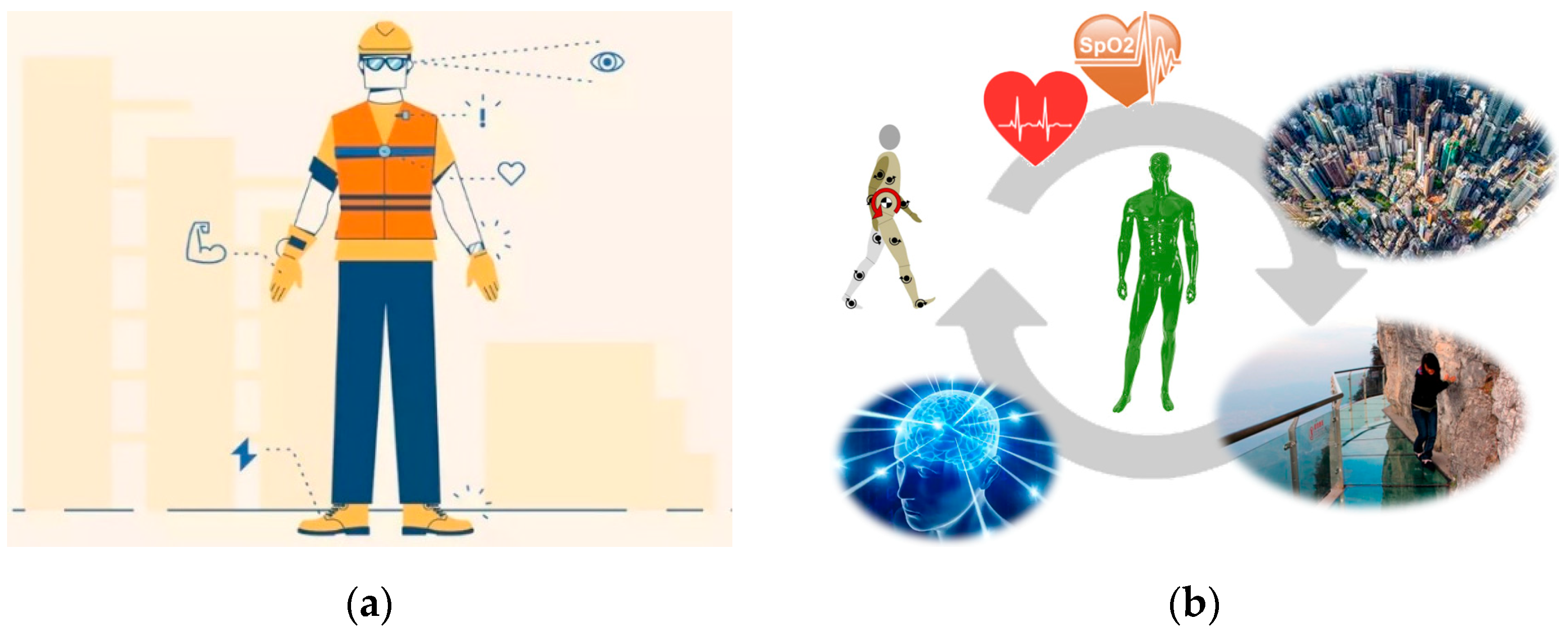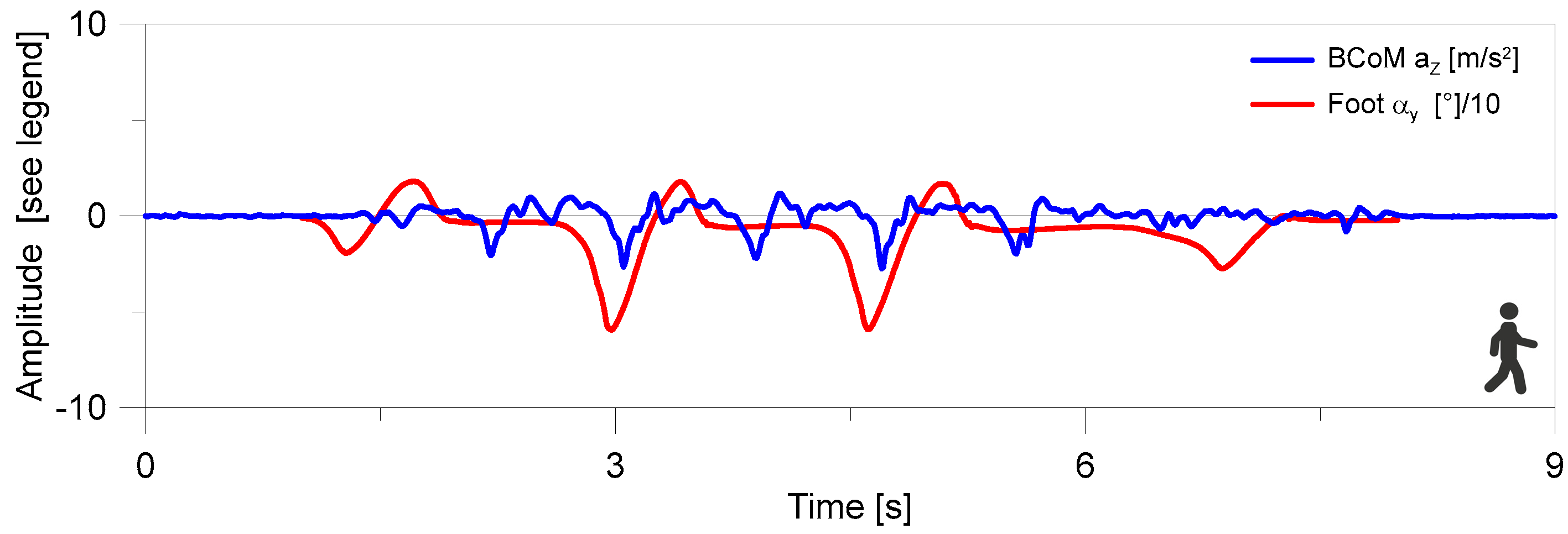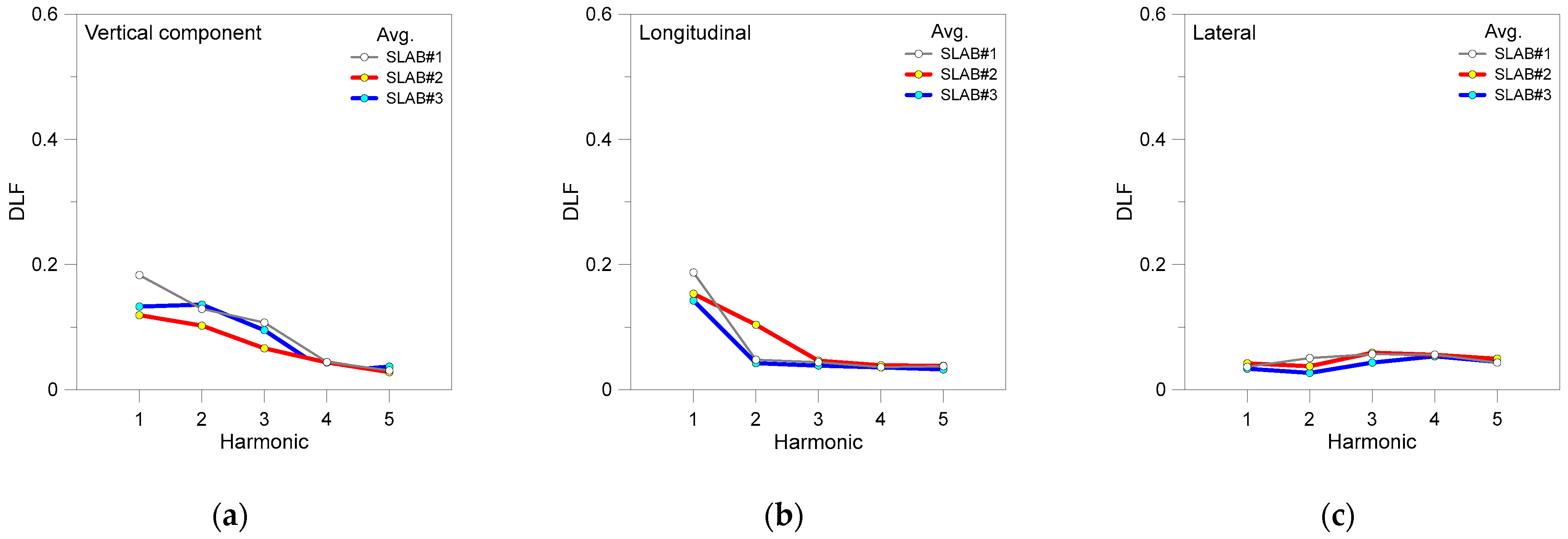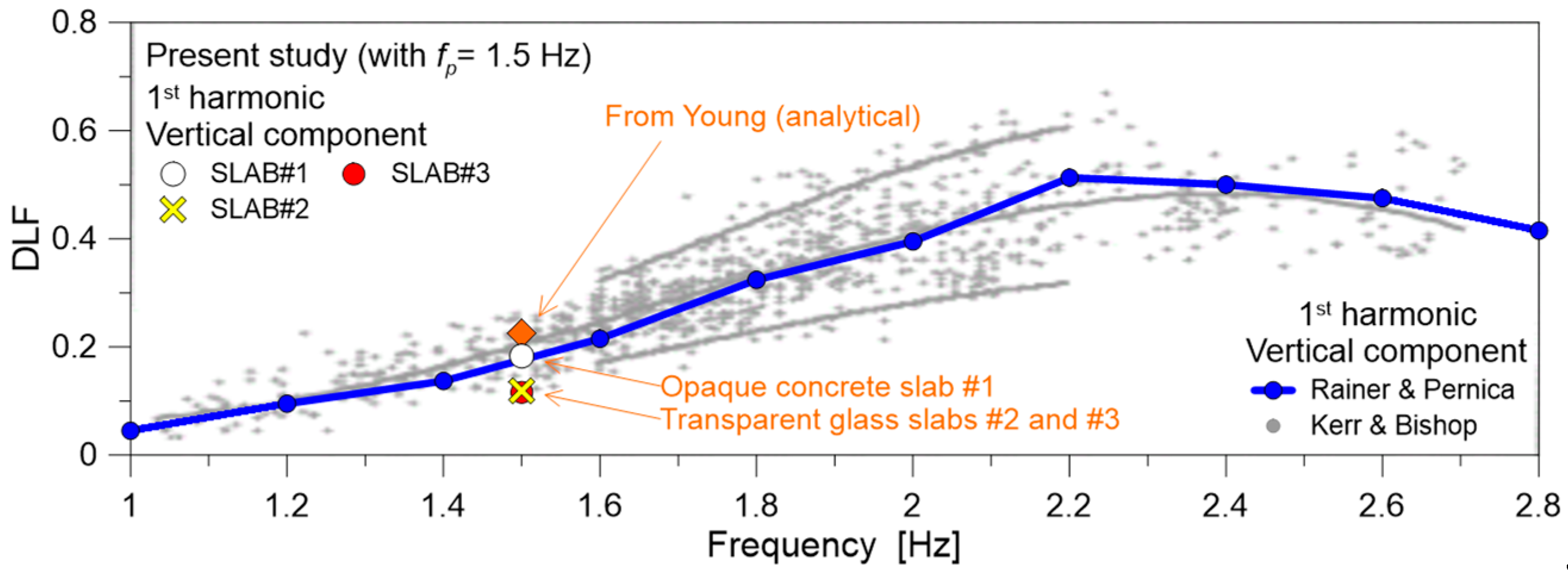Wearable and Smartphone-Based Sensors in Support of Human-Comfort-Driven Structural Analysis of Building Components †
Abstract
1. Introduction
2. Background and Goal
2.1. Sensors for Human-Comfort-Driven Structural Design
2.2. Present Elaboration
3. Experiments on Glass Structures
3.1. Setup
3.2. Sensors and Records
4. Experimental Evidence
5. Summary and Future Developments
Funding
Institutional Review Board Statement
Informed Consent Statement
Data Availability Statement
Conflicts of Interest
References
- Colenberg, S.; Jylha, T.; Arkesteijn, M. The relationship between interior office space and employee health and well-being—A literature review. Build. Res. Inf. 2020, 49, 352–366. [Google Scholar] [CrossRef]
- Levin, H. Designing for people: What do building occupants really want. In Proceedings of the ISIAQ 7th International Conference, Singapore, 7–11 December 2003; Volume 2, pp. 1–18. [Google Scholar]
- Abdel, A.M.G. Human thermal comfort and heat stress in an outdoor urban arid environment: A case study. Adv. Meteorol. 2013, 2013, 693541. [Google Scholar]
- Yun, G.Y.; Kim, J.T. Creating sustainable building through exploiting human comfort. Energy Procedia 2014, 62, 590–594. [Google Scholar] [CrossRef]
- Li, D.; Menassa, C.C.; Kamat, V.R. Personalized human comfort in indoor building environments under diverse conditioning modes. Build. Environ. 2017, 126, 304–317. [Google Scholar] [CrossRef]
- Bedon, C. Pilot experiments for multi-criteria human comfort-driven structural glass design assessment. Challenging Glass Conf. Proc. 2022, 8. [Google Scholar] [CrossRef]
- Oldham, G.R.; Rotchford, N.L. Relationships between office characteristics and employee reactions: A study of the physical environment. Adm. Sci. Q. 1983, 28, 542–556. [Google Scholar] [CrossRef]
- Bower, I.; Tucker, R.; Enticott, R.G. Impact of built environment design on emotion measured via neurophysiological correlates and subjective indicators: A systematic review. J. Environ. Psychol. 2019, 66, 101344. [Google Scholar] [CrossRef]
- Shearcroft, G. The joy of architecture: Evoking emotions through building. Archit. Des. 2021, 91, 108–117. [Google Scholar] [CrossRef]
- Vidal, F.J.; Abad, S.I. Introducing emotions in the architectural design process. In Proceedings of the 1st International Conference on Higher Education Advances, HEAd’15, Universitat Politecnica de Valencia, Valencia, Spain, 24–26 June 2015. [Google Scholar]
- Deriu, D. Skywalking in the city: Glass platforms and the architecture of vertigo. Emot. Space Soc. 2018, 28, 94–103. [Google Scholar] [CrossRef]
- Bedon, C. Body CoM acceleration for rapid analysis of gait variability and pedestrian effects on structures. Buildings 2022, 12, 251. [Google Scholar] [CrossRef]
- Bedon, C.; Noè, S. Uncoupled Wi-Fi Body CoM Acceleration for the Analysis of Lightweight Glass Slabs under Random Walks. J. Sens. Actuator Netw. 2022, 11, 10. [Google Scholar] [CrossRef]
- Bedon, C.; Mattei, S. Facial Expression-Based Experimental Analysis of Human Reactions and Psychological Comfort on Glass Structures in Buildings. Buildings 2021, 11, 204. [Google Scholar] [CrossRef]
- Bedon, C.; Mattei, S. Remote Facial Expression and Heart Rate Measurements to Assess Human Reactions in Glass Structures. Adv. Civ. Eng. 2021, 16, 2012. [Google Scholar] [CrossRef]
- Bachmann, H.; Ammann, W. Vibrations in Structures Induced by Man and Machines. In Structural Engineering Documents, 3rd ed.; International Association of Bridge and Structural Engineering (IABSE): Zurich, Switzerland, 1987. [Google Scholar]
- Bedon, C. Experimental investigation on vibration sensitivity of an indoor glass footbridge to walking conditions. J. Build. Eng. 2020, 29, 101195. [Google Scholar] [CrossRef]
- Bedon, C.; Fasan, M.; Noè, S. Body Motion Sensor Analysis of Human-Induced Dynamic Load Factor (DLF) for Normal Walks on Slender Transparent Floors. J. Sens. Actuator Netw. 2022, 11, 81. [Google Scholar] [CrossRef]
- Bedon, C.; Bergamo, E.; Izzi, M.; Noè, S. Prototyping and Validation of MEMS Accelerometers for Structural Health Monitoring—The Case Study of the Pietratagliata Cable-Stayed Bridge. J. Sens. Actuator Netw. 2018, 7, 30. [Google Scholar] [CrossRef]
- Bedon, C.; Zhang, X.; Santos, F.; Honfi, D.; Kozlowski, M.; Arrigoni, M.; Figuli, L.; Lange, D. Performance of structural glass facades under extreme loads—Design methods, existing research, current issues and trends. Constr. Build. Mater. 2018, 163, 921–937. [Google Scholar] [CrossRef]
- Bedon, C.; Fasan, M.; Amadio, C. Vibration Analysis and Dynamic Characterization of Structural Glass Elements with Different Restraints Based on Operational Modal Analysis. Buildings 2019, 9, 13. [Google Scholar] [CrossRef]
- Bedon, C.; Fasan, M. Reliability of Field Experiments, Analytical Methods and Pedestrian’s Perception Scales for the Vibration Serviceability Assessment of an In-Service Glass Walkway. Appl. Sci. 2019, 9, 1936. [Google Scholar] [CrossRef]
- Živanović, S.; Pavić, A.; Reynolds, P. Vibration serviceability of footbridges under human-induced excitation: A literature review. J. Sound Vib. 2005, 279, 1–74. [Google Scholar] [CrossRef]
- Sedlacek, G.; Heinemeyer, C.; Butz, C.; Veiling, B.; Waarts, P.; Duin, F.; Hicks, S.; Devine, P.; Demarco, P. Generalisation of Criteria for Floor Vibrations for Industrial, Office, Residential and Public Building and Gymnasium Halls; EU Commission: Luxembourg, 2006. [Google Scholar]
- Rainer, J.H.; Pernica, G. Vertical dynamic forces from footsteps. Can. Acoust. Acoust. Can. 1986, 14, 12–21. [Google Scholar]
- Kerr, S.C.; Bishop, N.W.M. Human induced loading on flexible staircases. Eng. Struct. 2001, 23, 37–45. [Google Scholar] [CrossRef]
- Young, P. Improved Floor Vibration Prediction Methodologies. In Proceedings of Arup Vibration Seminar on Engineering for Structural Vibration—Current Developments in Research and Practice; Institution of Mechanical Engineers: London, UK, 2001. [Google Scholar]





| SLAB | Material | Span | Surface | Thickness | Mass | Frequency |
|---|---|---|---|---|---|---|
| [m] | [m2] | [m] | [kg] | [Hz] | ||
| #1 | Concrete | 13 | 110.5 | 0.80 | 221,000 | >80 1 |
| #2 | Glass + steel | 2.65 | 4.37 | 0.04352 | 460 | 15.1 2 |
| #3 | Glass + steel | 14.5 | 40.6 | 0.04352 | 4020 | 7.28 3 |
Disclaimer/Publisher’s Note: The statements, opinions and data contained in all publications are solely those of the individual author(s) and contributor(s) and not of MDPI and/or the editor(s). MDPI and/or the editor(s) disclaim responsibility for any injury to people or property resulting from any ideas, methods, instructions or products referred to in the content. |
© 2023 by the author. Licensee MDPI, Basel, Switzerland. This article is an open access article distributed under the terms and conditions of the Creative Commons Attribution (CC BY) license (https://creativecommons.org/licenses/by/4.0/).
Share and Cite
Bedon, C. Wearable and Smartphone-Based Sensors in Support of Human-Comfort-Driven Structural Analysis of Building Components. Eng. Proc. 2023, 35, 12. https://doi.org/10.3390/IECB2023-14586
Bedon C. Wearable and Smartphone-Based Sensors in Support of Human-Comfort-Driven Structural Analysis of Building Components. Engineering Proceedings. 2023; 35(1):12. https://doi.org/10.3390/IECB2023-14586
Chicago/Turabian StyleBedon, Chiara. 2023. "Wearable and Smartphone-Based Sensors in Support of Human-Comfort-Driven Structural Analysis of Building Components" Engineering Proceedings 35, no. 1: 12. https://doi.org/10.3390/IECB2023-14586
APA StyleBedon, C. (2023). Wearable and Smartphone-Based Sensors in Support of Human-Comfort-Driven Structural Analysis of Building Components. Engineering Proceedings, 35(1), 12. https://doi.org/10.3390/IECB2023-14586






